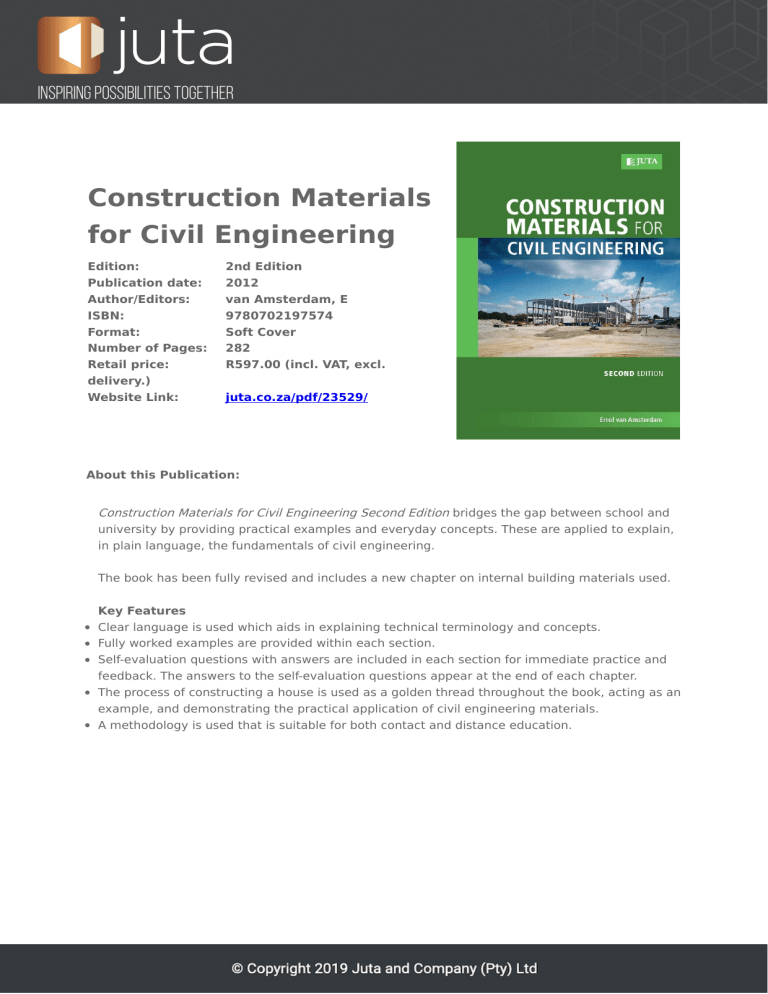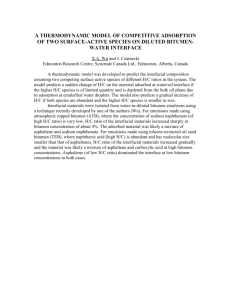
Construction Materials for Civil Engineering Edition: 2nd Edition Publication date: Author/Editors: ISBN: Format: Number of Pages: Retail price: delivery.) Website Link: 2012 van Amsterdam, E 9780702197574 Soft Cover 282 R597.00 (incl. VAT, excl. juta.co.za/pdf/23529/ About this Publication: Construction Materials for Civil Engineering Second Edition bridges the gap between school and university by providing practical examples and everyday concepts. These are applied to explain, in plain language, the fundamentals of civil engineering. The book has been fully revised and includes a new chapter on internal building materials used. Key Features Clear language is used which aids in explaining technical terminology and concepts. Fully worked examples are provided within each section. Self-evaluation questions with answers are included in each section for immediate practice and feedback. The answers to the self-evaluation questions appear at the end of each chapter. The process of constructing a house is used as a golden thread throughout the book, acting as an example, and demonstrating the practical application of civil engineering materials. A methodology is used that is suitable for both contact and distance education. Contents Include: Chapter 1 Soils 1.1 Introduction 1.2 Nature of soils 1.3 Identification of soil 1.4 Classification of soil 1.5 Soil survey procedure 1.6 Compaction 1.7 Quarries 1.8 Stabilisation 1.9 Slopes 1.10 Reinforced earth 1.11 Summary Chapter 2 Concrete 2.1 2.2 2.3 2.4 2.5 2.6 Introduction General concrete specifications Materials for concrete Mix proportions and quantities Concrete mix design Concrete production 2.7 Reinforcement 2.8 Joints 2.9 Precast concrete 2.10 Prestressed concrete 2.11 Concrete roads 2.12 Summary Chapter 3 Bitumen 3.1 Introduction 3.2 Sources of bitumen 3.3 Bitumen and tar 3.4 The production of bitumen 3.5 The composition of bitumen 3.6 The behaviour and characteristics of bitumen 3.7 Types of bitumen 3.8 Sampling 3.9 Tests on bitumen 3.10 Applications of bitumen 3.11 Health and safety 3.12 Summary Chapter 4 Structural materials: bricks, timber, steel and aluminium 4.1 Introduction 4.2 4.3 4.4 4.5 4.6 Bricks Timber Metal Aluminium Summary Chapter 5 Environmental issues 5.1 Environmental engineering 5.2 The interdependence of conservation and development 5.3 Population figures 5.4 Soil erosion 5.5 Water pollution 5.6 Toxic waste 5.7 Air pollution 5.8 The balance between humans and nature 5.9 Sewage 5.10 Eutrophication 5.11 Summary Chapter 6 Internal building construction materials used for finishes 6.1 Introduction 6.2 Floor coverings 6.3 Painting 6.4 Timber flooring Of Interest and Benefit to: Construction Materials for Civil Engineering Second Edition is written for tertiary students who are studying towards a National Diploma or Bachelor’s degree in Civil Engineering. It is essential reading for anyone looking to gain a firm grounding in the application of materials within the field of civil engineering in general.

